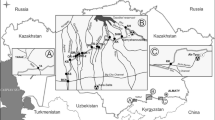Abstract
With the example of the Iput river, studies are performed and based on them an analysis is made of the formation of contamination of elements of a river system by radionuclides 137Cs and 90Sr after the accident at the Chernobyl Nuclear Power Plant. It has been revealed that before the years 1990–1994 the contamination of the river system was mainly formed by the primary fallout of radionuclides on the water surface of the river but after the year 2000 it will be determined only by the ingress of radioactive contaminants with surface flow from a water catchment. The studies have shown that the contamination of the Iput river in the territory of Belarus is substantially influenced by the transfrontier transfer of radionuclides from the territory of Russia. According to our estimates, at the end of 1986, this contribution amounted to 30% for 137Cs and 96% for 90Sr; as of now, it is 86% and 65% for 137Cs and 90Sr, respectively.
Similar content being viewed by others
REFERENCES
Resources of Surface Water of the USSR. Description of Rivers and Lakes, Vol. 5, Belorussia and the Upstream Near-Dnieper Territory, Pt. 1 [in Russian], Leningrad (1971).
O. M. Zhukova, N. M. Shiryaeva, N. K. Myshkina, V. V. Denisova, and V. V. Skurat, Prediction of Migration of Cesium-137 in the Basin of the Iput River, Preprint No. 30 of the Institute of Radioenvironmental Problems [in Russian], Minsk (2000).
O. M. Zhukova, N. M. Shiryaeva, N. K. Myshkina, V. V. Denisova, and V. V. Skurat, Chamber Model of Migration of Radionuclides in the River System under Different Conditions of Ingress of Radioactive Contamination, Preprint No. 26 of the Institute of Radioenvironmental Problems [in Russian], Minsk (1999).
Map of the Radiation Situation on the Territory of the Dobrush District of the Gomel Region of the BSSR as of January 1991 [in Russian], Moscow (1991).
Atlas of Radioactive Contamination of the European Part of Russia, Belorussia, and Ukraine [in Russian], Moscow (1998), pp. 92–93.
M. A. Novitskii, A. I. Nikitin, V. B. Chumichev, and L. A. Bovkun, in: Migration of Radionuclides in Water Systems [in Russian], Obninsk (1995), pp. 109–114.
Modeling and Study of the Mechanisms of the Transfer of Radioactive Material from Terrestrial Ecosystems to and in Water Bodies around Chernobyl, Experimental Collaboration Project No. 3-EUR 16525EN (1996).
S. S. Beletskii, in: Complex Use and Protection of the Underground Water of the BSSR [in Russian], Minsk (1976), pp. 20–42.
N. A. Nazarov, Vodn. Resursy, 26, No. 6, 645–652 (1996).
Yu. A. Izraél, Chernobyl: Radioactive Contamination of the Natural Environments [in Russian], Leningrad (1990).
O. M. Zhukova, I. I. Matveenko, N. K. Myshkina, G. A. Sharovarov, and N. M. Shiryaeva, Inzh.-Fiz. Zh., 70, No. 1, 73–80 (1997).
Author information
Authors and Affiliations
Rights and permissions
About this article
Cite this article
Zhukova, O.M., Shiryaeva, N.M., Myshkina, N.K. et al. Distinctive Features of the Formation and Migration of Radioactive Contamination in the Iput River after the Accident at the Chernobyl Nuclear Power Plant. Journal of Engineering Physics and Thermophysics 74, 1305–1311 (2001). https://doi.org/10.1023/A:1012961123897
Issue Date:
DOI: https://doi.org/10.1023/A:1012961123897




